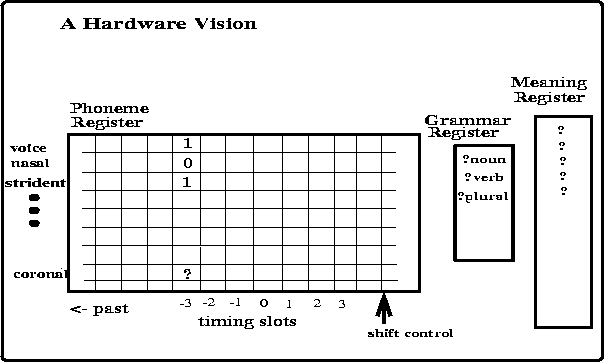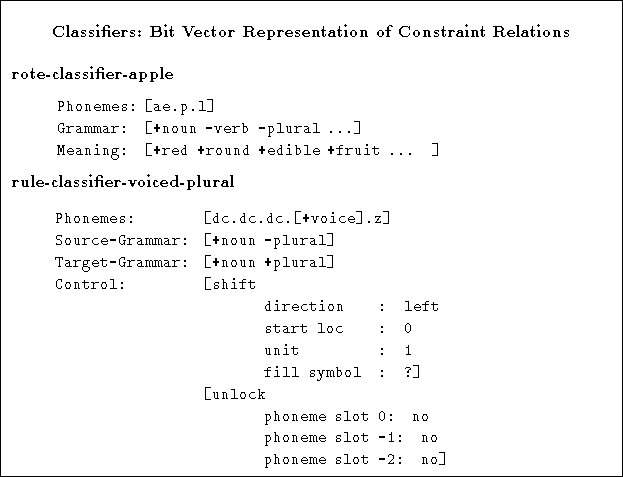Our performance model is implemented as a hardware mechanism. The choice of mechanism limits the range of behavior that can be developed. Thus a mechanism that exhibits human-like phonological behavior gives us an upper limit on the complexity necessary to produce that behavior. By restricting ourselves to a simple mechanism limited in the kinds of parts that we may postulate and in the ways they may be connected, we construct a robust theory. Our aim is to show that phonological behavior is a natural consequence of the organization of the hardware.
The mechanism consists of data registers and constraint elements. The data registers hold the state of the computation as linguistic events are processed. (See Figure 1.) The linguistic information is described in terms of boolean features (bits). The constraint elements embody phonological knowledge relating sound and meaning patterns. For example, the plural constraints distinguish the variants of the plural morphemes ([z], [s], and [I.z]) conditioned by the last phoneme of a common noun.
The constraint elements enforce boolean relations among the values of
the features in the registers. If there is sufficient information
available in those features for the element to infer the values of
unassigned features, those features are assigned the required values.
If the information in the registers is inconsistent with the relation
enforced by a constraint element, this conflict is
noted.![]()

Figure 1: The hardware mechanism consists of three data registers. In the
Phoneme Shift Register, each vertical stripe represents a
time slot. There are slots for future phonemes (positive time labels)
as well as past phonemes (negative time labels). Each horizontal
stripe represents a distinctive feature bit. For example, if the
phoneme in time slot -3 is known to be a voiced non-nasal then in the
column labeled -3 the voice entry would be 1 and the nasal entry would
be 0. If the phoneme is known to be strident, the strident entry
would be 1. If a feature is unknown, as in the coronal bit, we leave
a question mark. The Grammar Register contains bits describing the
grammatical status of the phoneme sequence. The Meaning Register
contains meaning bits.
A linguistic event might be the hearing or speaking of a word. An event is described by three types of information: sound, grammar, and meaning. The sound pattern of a word, represented as a sequence of discrete phonemes, is stored in a shift register called the phoneme register. Each time slot of the phoneme register holds a vector of 14 binary-valued distinctive features representing a particular phoneme. (See Figure 2.) As the speech sound is heard, the phoneme sequence is shifted. The grammatical information of the word (such as its part of speech, number, and gender) is stored as a vector of grammatical features in the grammar register. The meaning register contains a set of bits intended to identify the ``meaning'' of the word. The bits in the grammar register and the meaning register do not have a sharp boundary: The grammar bits are particularly crude components of the meaning that have special significance in the phonological context. Of course, we do not claim to have a theory of meaning. Our theory of the acquisition of phonological knowledge requires only the information that ``apples'' is the plural noun form of ``apple'' or that ``walked'' is the past-tense verb form of ``walk.'' We implement this by identifying the underlying word stem with an arbitrary set of feature bits. For mnemonic value we label these bits with symbols like [+red].

Figure 2: The sound pattern of a word is represented by a sequence of
phonemes. For example, the word ``apples'' consists of four phonemes.
Each phoneme is uniquely characterized by its values on the 14
distinctive features. Phonetic symbols are enclosed in square
brackets. For example, [ae] is the symbol for the low [+low], front
[-back], lax [-tense] vowel in ``apples.'' Each feature vector
is indexed by a time instant. The column labeled by time = 0
corresponds to the most recently heard phoneme. Phonemes with negative
time indices are already heard.
The bits in the registers have four possible states {0, 1, ?, *}. The bits can be set by an external linguistic event or by constraint relations. If the value of a bit is currently unknown it contains an unknown symbol (?). If a bit is asserted to be both 1 and 0 because of a disagreement among the constraints it participates in, it is in the conflict state, which we denote by (*).
The core of the performance model is a collection of constraint elements. These constraint elements continuously monitor the data registers. When a linguistic event appears, the constraint elements will be excited to various degrees. The most excited constraint element takes control over the data registers, and enforces its relation on slots that it is connected to by setting bits in slots containing ``?'' to definite values. The assignment of definite values to these slots may trigger other constraints, and thus the propagation may fill in many unknown values.
The constraint relation enforced by a constraint element is represented by a bit vector. We refer to these bit vectors as classifiers. A classifier is a finite string over the three-symbol alphabet 0,1,-. A ``1'' (or ``0'') typically represents the presence (or absence) of a characteristic. A ``-'' means don't care, i.e., the bit's actual value does not matter.
There are two types of classifiers: rote-classifier and rule-classifier. (See Figure 3.) The rote-classifiers are intended to capture correlations among the bit patterns in the data registers. For example, a rote-classifier for ``apple'' enforces a certain constraint among the phonemes [ae.p.l] in the phoneme register, the [+noun,-verb,-plural...] features in the grammar register, and the bits in the meaning register.

Figure 3: Two types of classifiers. We use symbolic
notations to simplify the description of a classifier. The notation
[ae.p.l] refers to the 42 bits ( ![]() ) representing the
distinctive features of the phonemes enclosed in the square brackets.
The symbol ``dc'' for a phoneme abbreviates a string of 14 don't-care
bits. The notation [+noun] indicates that the noun bit in the
classifier is on. Top: The rote-classifier ``apple'' correlates
the sound pattern [ae.p.l] with the grammar and meaning bits of the
word. Bottom: The rule-classifier ``voiced-plural'' relates a
singular (i.e. [-plural]) common noun ending in a voiced phoneme
with its plural form. If the bit pattern in the grammar register
matches the source-grammar component of a rule-classifier,
the constraint element described by the rule-classifier produces a
plural form by shifting the phoneme register left one slot (as
specified in the control component of the rule-classifier description)
and filling the unknowns in the terminal
slot with a [z] phoneme. If the pattern in the grammar register matches the
target-grammar component, the constraint element produces a singular form by
reversing the control actions. The unlock privilege grants (or
refuses) write access by the classifier to the last 3 phoneme slots.
) representing the
distinctive features of the phonemes enclosed in the square brackets.
The symbol ``dc'' for a phoneme abbreviates a string of 14 don't-care
bits. The notation [+noun] indicates that the noun bit in the
classifier is on. Top: The rote-classifier ``apple'' correlates
the sound pattern [ae.p.l] with the grammar and meaning bits of the
word. Bottom: The rule-classifier ``voiced-plural'' relates a
singular (i.e. [-plural]) common noun ending in a voiced phoneme
with its plural form. If the bit pattern in the grammar register
matches the source-grammar component of a rule-classifier,
the constraint element described by the rule-classifier produces a
plural form by shifting the phoneme register left one slot (as
specified in the control component of the rule-classifier description)
and filling the unknowns in the terminal
slot with a [z] phoneme. If the pattern in the grammar register matches the
target-grammar component, the constraint element produces a singular form by
reversing the control actions. The unlock privilege grants (or
refuses) write access by the classifier to the last 3 phoneme slots.
Rule-classifiers are intended to capture phonological constraints. Most phonological constraints deal with predictable regularities of the sound structure that are blind to semantic information. That the plural of ``cat'' is pronounced as cat[s] but not cat[z] has nothing to do with the fact that a cat is a domesticated carnivorous mammal. It is convenient to assume that whatever semantic information might be relevant to the applicability of a phonological constraint is already abstracted into the grammatical information. This assumption simplifies the description of a rule-classifier: a rule-classifier is not connected to the meaning register and therefore its description does not contain any meaning component.